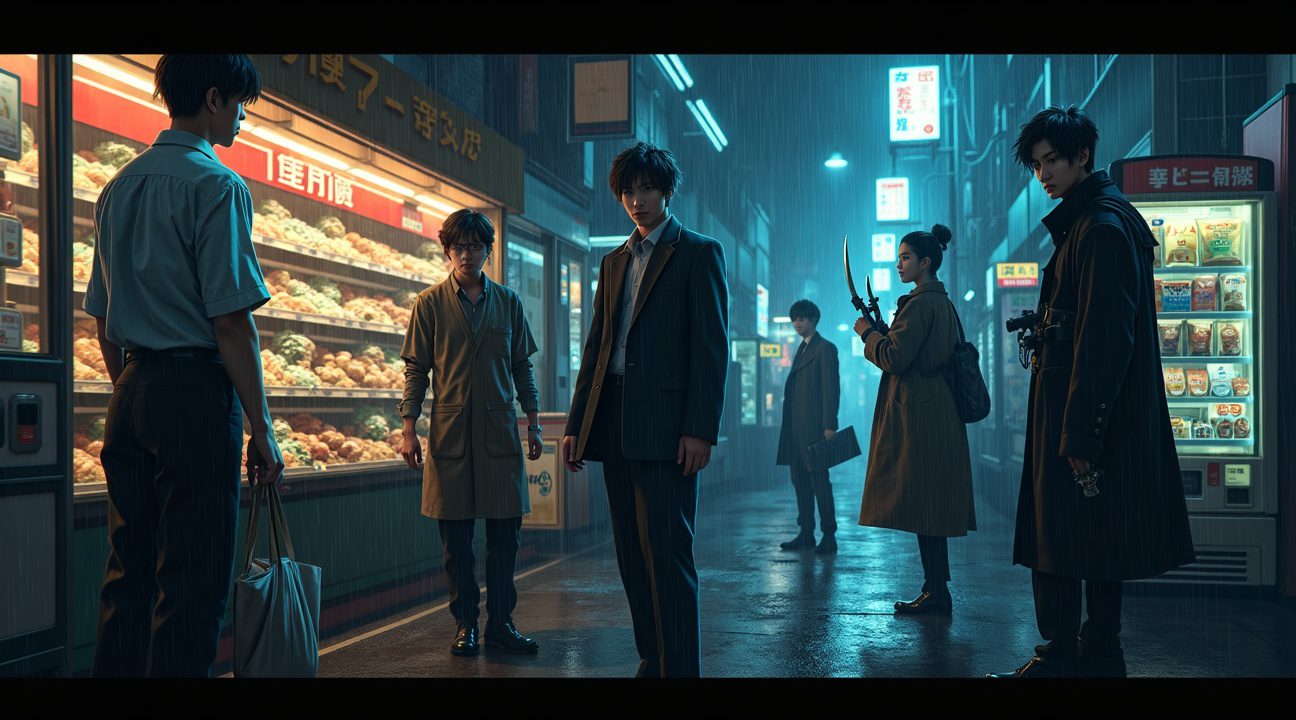The highly anticipated live-action adaptation of Sakamoto Days will hit theaters during Japan’s Golden Week in 2026, featuring Snow Man’s Ren Meguro as the legendary ex-hitman turned convenience store owner, Taro Sakamoto.
Film Overview
Fans of the Sakamoto Days manga series have eagerly awaited its live-action transition, and the wait will culminate in spring 2026. With Golden Week being one of Japan’s most profitable movie windows, expectations are high for a strong box office performance. Helmed by acclaimed director Yuichi Fukuda, whose previous works include Gintama and Under Ninja, this adaptation promises a charismatic blend of humor and action.
Ren Meguro as Taro Sakamoto
Ren Meguro, a prominent member of the idol group Snow Man, will portray the titular character, Taro Sakamoto. His casting not only brings acting experience but also draws in a devoted fanbase, enhancing the film’s commercial appeal.
Key Takeaways
- Ren Meguro from popular idol group Snow Man stars as Taro Sakamoto, bringing significant star power and fanbase appeal to the manga adaptation.
- The film targets Japan’s lucrative Golden Week release period in late April to early May 2026, positioning it for maximum domestic box office success.
- Director Yuichi Fukuda and action director Keiya Tabuchi combine their expertise from successful manga adaptations like Gintama and Evangelion to handle the series’ unique tone.
- Production has advanced significantly with editing complete as of September 2025, while CGI work and music composition continue to enhance visual and emotional quality.
- The adaptation faces the intricate challenge of translating the manga’s distinctive blend of domestic comedy and intense assassin action into live-action format while maintaining its emotional core.
Final Thoughts
As 2026 approaches, anticipation continues to build for what could be one of the most compelling manga-to-film adaptations in recent years. With a proven creative team and a strategic release date, Sakamoto Days looks set to impress both longtime fans and new audiences alike.
Snow Man’s Ren Meguro Stars as Legendary Ex-Hitman in Golden Week 2026 Premiere
The highly anticipated live-action adaptation of Sakamoto Days has officially cast Ren Meguro from the popular idol group Snow Man as the lead character, Taro Sakamoto. This casting choice brings significant star power to the project, as Meguro’s dedicated fanbase from his music career will likely drive additional interest in the film adaptation.
Meguro has openly shared his enthusiasm for taking on this challenging role, citing his genuine appreciation for the original manga series. His passion for the source material suggests a commitment to delivering an authentic portrayal of the beloved ex-hitman character. The casting represents a strategic move that bridges the gap between manga enthusiasts and mainstream entertainment audiences.
Golden Week 2026 Release Strategy
The film is set to premiere during Japan’s Golden Week period in late April to early May 2026, positioning it perfectly for maximum domestic box office success. This timing traditionally represents one of the most lucrative release windows in Japanese cinema, similar to how live-action adaptations often target peak seasons for optimal audience engagement.
The production team has already released a teaser trailer alongside key visual materials, generating substantial buzz among both manga readers and general audiences. These promotional materials confirm the high production values and serious approach being taken with this adaptation. Industry observers note the strong anticipation building around the project, particularly given the manga’s established popularity.
While no international release dates have been confirmed yet, the global success of the original manga creates strong expectations for worldwide distribution. The series has cultivated a substantial international following, making it likely that distributors will pursue broad international releases following the Japanese premiere. This pattern mirrors other successful manga adaptations that have found audiences far beyond their domestic markets.
The combination of Meguro’s star power, the Golden Week release strategy, and the built-in fanbase from the manga creates a promising foundation for commercial success. Early promotional efforts suggest confidence from the production team in delivering an adaptation that honors the source material while appealing to broader audiences. The 2026 release timeline allows sufficient production time to ensure quality execution of the action sequences and character development that fans expect from this beloved series.

Star-Studded Production Team Brings Action Expertise from Gintama and Evangelion
The Sakamoto Days live-action adaptation benefits from an experienced creative team that brings proven expertise in both comedy and high-octane action sequences. Yuichi Fukuda takes the helm as both director and writer, drawing from his successful track record with live-action manga adaptations including Gintama and Under Ninja. His approach balances intense action with the comedic elements that define Sakamoto Days, making him an ideal choice for capturing the series’ unique tone.
Action Direction Excellence
Keiya Tabuchi’s involvement as action director elevates the project’s potential for spectacular fight choreography. His impressive portfolio includes work on Evangelion: 3.0+1.0: Thrice Upon A Time and the live-action Attack on Titan, demonstrating his ability to translate complex animated sequences into compelling live-action scenes. Tabuchi’s expertise suggests the film will feature innovative and dynamic action that honors the manga’s reputation for creative combat scenarios.
The production gains additional credibility through the involvement of CREDEUS and Avex Pictures, two companies with extensive experience in large-scale Japanese film and animation projects. Their combined resources and industry connections position the adaptation for both domestic success and international distribution potential.
Advanced Production Timeline
Current production status reveals significant progress, with editing reportedly complete as of September 2025. This milestone indicates the filming phase has concluded successfully and the core narrative structure is finalized. However, post-production work continues on two critical elements that will define the final product’s quality.
CGI work remains ongoing, which proves essential given Sakamoto’s superhuman abilities and the series’ emphasis on over-the-top action sequences. The extended post-production timeline allows for detailed visual effects that can properly represent the manga’s distinctive style without compromising practical action elements.
Music composition also continues in development, representing another crucial component for establishing the film’s emotional beats and action intensity. The combination of Fukuda’s directorial vision, Tabuchi’s action expertise, and the production companies’ resources creates a foundation for a live-action adaptation that respects its source material while delivering cinema-quality entertainment. This careful attention to both technical and creative elements positions the 2026 release for potential success among both existing fans and newcomers to the Sakamoto Days universe.
From Legendary Hitman to Convenience Store Owner: The Story Behind Sakamoto Days
Yuto Suzuki’s creative journey with Sakamoto Days began as a one-shot in December 2019, capturing readers’ attention before evolving into the full-fledged series that debuted in Weekly Shonen Jump in November 2020. This manga presents a refreshingly unique premise that blends action, comedy, and family values in ways that few series manage to achieve.
The Unlikely Hero’s Transformation
Taro Sakamoto stands as one of manga’s most compelling protagonists – a former legendary hitman who traded his deadly profession for domestic bliss. After falling in love, Sakamoto made the radical decision to retire from assassination work, choosing instead to operate a humble convenience store. This dramatic lifestyle shift forms the emotional core of the series, showcasing how love can completely transform even the most hardened individuals.
Sakamoto’s transformation isn’t just career-related; his entire physical appearance changed as he embraced civilian life. The once-feared assassin gained considerable weight, developed a gentle demeanor, and seemingly left his violent past behind. However, his extraordinary skills remain intact beneath this peaceful exterior, creating a fascinating dichotomy that drives much of the series’ tension and humor.
When the Past Refuses to Stay Buried
Peace proves elusive for Sakamoto as his legendary reputation attracts unwanted attention. Bounties appear on his head, drawing elite assassins and old rivals who see him as either a target or a challenge to overcome. These antagonists refuse to accept that the legendary hitman has truly retired, forcing Sakamoto into situations where he must defend himself and his loved ones.
The series excels at exploring the moral complexity of Sakamoto’s situation. Despite mounting threats, he maintains his resolve to avoid killing, creating unique action sequences where he must neutralize opponents without taking lives. This self-imposed limitation adds layers of difficulty to every confrontation while staying true to his character development. Much like how live-action adaptations must balance source material with practical constraints, Sakamoto must balance his lethal abilities with his moral boundaries.
The supporting cast enriches the narrative considerably. His family and neighborhood friends represent the normal life he’s fighting to protect, while former colleagues and new enemies embody the violent world he’s trying to escape. These relationships create emotional stakes that extend beyond simple action sequences, making readers genuinely invested in Sakamoto’s struggle to maintain his peaceful existence.
Recent developments have heightened the stakes significantly. As of August 2025, the series entered its “final battle” arc, suggesting that Suzuki is building toward a climactic resolution of Sakamoto’s ongoing conflict between his past and present. This development indicates continued plot momentum and sustained reader interest, factors that likely influenced the decision to pursue a live-action adaptation.
The manga’s popularity stems from its ability to subvert expectations while delivering genuine emotional moments. Readers expect certain behaviors from action heroes, but Sakamoto consistently chooses family over violence, peace over glory. This approach resonates with audiences who appreciate character growth and moral complexity in their entertainment. Similar to how anime adaptations can bring fresh perspectives to familiar stories, Sakamoto Days offers a fresh take on the action genre.
Suzuki’s artwork complements the storytelling perfectly, shifting seamlessly between comedic moments in the convenience store and intense action sequences. The visual contrast between Sakamoto’s current appearance and his flashback scenes as a lean, dangerous assassin reinforces the character’s transformation while hinting at the power that lies dormant within him.
The series has maintained consistent quality throughout its run, avoiding the common pitfall of action manga that rely too heavily on escalating violence. Instead, Sakamoto Days focuses on:
- Creative problem-solving
- Character relationships
- The ongoing tension between Sakamoto’s two worlds
This approach has kept readers engaged and likely contributed to the confidence producers have in adapting it for the big screen.

Meet the Assassins: Key Characters Set to Appear in the Live-Action Film
The upcoming 2026 adaptation brings together a fascinating ensemble of characters who define what makes Sakamoto Days such a compelling story. Each character carries their own unique blend of deadly skills and personal motivations that should translate powerfully to the big screen.
The Heart of the Story: Sakamoto and His Inner Circle
Taro Sakamoto stands as the centerpiece of this action-packed narrative. Once considered the most feared hitman in the underworld, he’s transformed into an overweight convenience store owner who prioritizes his family above all else. His legendary combat skills remain intact beneath his domestic exterior, creating a character who can shift from mundane shopkeeper to lethal force in seconds. Sakamoto’s journey from killer to family man forms the emotional core that makes the story resonate beyond its action sequences.
Shin Asakura brings a fresh dynamic as Sakamoto’s unlikely apprentice. This telepathic rookie assassin possesses mind-reading abilities that compensate for his inexperience in combat. His relationship with Sakamoto develops from mentor-student into something closer to family, providing both comedic moments and genuine character growth throughout their adventures.
Hana Sakamoto represents the grounding force in her husband’s chaotic world. Far from being a passive spouse, she demonstrates remarkable strength and awareness of her husband’s dangerous past while maintaining their peaceful domestic life. Her tough exterior and unwavering support create a character who can hold her own against the story’s more volatile elements.
Lu Xiaotang, known as Akao, enters the story as a skilled Chinese assassin who becomes a crucial ally to Sakamoto’s group. Her expertise and reliability make her an invaluable team member, and her presence adds international flavor to the predominantly Japanese cast. The character’s fighting style and strategic thinking should provide exciting action sequences in the film adaptation.
The Antagonistic Forces
Gaku presents one of the story’s most complex relationships as Sakamoto’s former colleague turned adversary. Their shared history creates tension that goes beyond simple good versus evil dynamics. Understanding their past partnership adds layers to confrontations that should translate into emotionally charged scenes on screen. This character represents the path Sakamoto could have taken if he hadn’t chosen family over his assassin lifestyle.
Nagumo rounds out the core cast as a flamboyant assassin whose mysterious connection to Sakamoto’s past adds intrigue to the narrative. His unpredictable nature and theatrical personality provide both comic relief and genuine threat, making him one of the series’ most memorable characters. The history between Nagumo and Sakamoto promises to deliver some of the film’s most intense dramatic moments.
The 2026 live-action adaptation faces the challenge of balancing these characters’ deadly skills with their human relationships. Success will depend on casting choices that can embody both the physical demands of the action sequences and the emotional depth required for the quieter character moments. Each assassin brings distinct fighting styles and personality quirks that should create visually striking and emotionally engaging scenes.
The film’s potential extends beyond typical action fare because these characters operate in a world where violence intersects with everyday life. Sakamoto’s convenience store serves as neutral ground where former enemies might shop for groceries, while deadly confrontations can erupt in the most mundane settings. This unique blend of domestic comedy and intense action distinguishes the property from other live-action adaptations of popular manga series.
Production teams working on this adaptation can draw inspiration from recent successes in bringing manga characters to life while avoiding the pitfalls that have plagued other live-action projects. The key lies in respecting the source material’s balance between humor and genuine emotional stakes that make these assassins feel like real people rather than cartoon characters.

How Sakamoto Days Revolutionized the Assassin Genre Through Comedy and Heart
Sakamoto Days transformed the assassin genre by seamlessly weaving comedy and slice-of-life moments into high-octane action sequences. Creator Yuto Suzuki crafted something genuinely fresh by centering the story around Taro Sakamoto, a former legendary assassin who’s traded his deadly skills for domestic bliss. This shift from the typical lone-wolf assassin archetype creates a protagonist readers can actually relate to – someone juggling family responsibilities while his dangerous past refuses to stay buried.
Breaking Genre Conventions Through Character Development
The manga’s brilliance lies in its subversion of traditional assassin story tropes. Instead of glorifying violence, Sakamoto Days examines what happens when someone wants to leave that life behind. Sakamoto’s transformation from feared killer to devoted family man provides the emotional core that elevates the series beyond standard action fare. His character development demonstrates that strength isn’t just about combat prowess – it’s about protecting what matters most. The supporting cast further enriches this formula, with each character bringing their own comedic quirks while maintaining genuine depth.
Innovative Action Choreography Meets Authentic Emotion
Suzuki’s fight choreography stands out for its creativity and visual storytelling. The action sequences blend practical combat with absurd comedy, creating memorable moments that feel both thrilling and genuinely funny. What sets these fights apart is how they’re grounded in character motivations rather than existing purely for spectacle. Each battle serves the story while showcasing the innovative ways Suzuki combines humor with intense action.
The series gained rapid international recognition precisely because it offers something different. Rather than following the typical path of escalating violence, Sakamoto Days focuses on character-driven narratives that resonate across cultures. This approach helped establish its strong following both in Japan and internationally, proving that audiences hunger for stories that balance entertainment with emotional authenticity.
The upcoming film adaptation represents part of a larger trend where prestigious Weekly Shonen Jump series receive major multimedia treatment. Live-action adaptations of manga properties continue gaining momentum, with studios recognizing the global appeal of these character-driven stories. The success of series like Sakamoto Days demonstrates how modern manga can revolutionize established genres by prioritizing heart and humor alongside traditional action elements.
This unique blend of comedy, family dynamics, and expertly crafted action sequences positions Sakamoto Days as a standout entry in the assassin genre. The series proves that innovation comes not from abandoning genre conventions entirely, but from finding new ways to make them feel fresh and emotionally resonant.
From Page to Screen: The Challenge of Adapting Sakamoto Days’ Unique Tone
The upcoming live-action adaptation faces a monumental task in capturing the distinctive essence that makes Sakamoto Days such a beloved manga. The anime adaptation released in two cours demonstrates the careful attention needed to preserve the source material’s identity, with the first concluding in March 2025 and the second airing from July 2025. This dual-season approach allows for proper character development and story pacing that the live-action film must now compress into a single cinematic experience.
Director Yuichi Fukuda’s previous adaptations have garnered mixed reviews from critics and audiences alike, highlighting the inherent difficulty of translating manga’s visual storytelling to live-action format. The challenge becomes even more complex when considering Sakamoto Days’ unique blend of comedy and intense action sequences. The manga’s sales have reportedly exceeded significant volumetric benchmarks, proving its popularity and raising expectations for faithful adaptation.
Balancing Comedy and Choreography
The film’s biggest hurdle lies in translating the manga’s innovative fight choreography to live-action while maintaining its comedic timing. Several key elements require careful consideration:
- The seamless integration of humor within high-stakes action sequences that defines the series
- Sakamoto’s distinctive fighting style that contrasts his current domestic lifestyle with his legendary assassin past
- The visual gags and physical comedy that rely heavily on manga’s static panel structure
- Character interactions that depend on precise timing and facial expressions
The production team must find creative solutions to preserve the manga’s signature tone without sacrificing either the comedy or action elements. Recent successes like live-action adaptations have shown that careful attention to source material can yield positive results, though failures remain equally common.
Fukuda’s experience with comedy-action hybrids provides some confidence, yet each adaptation presents unique challenges. The film must capture Sakamoto’s transformation from feared assassin to devoted family man while delivering the explosive action sequences fans expect. This delicate balance requires sophisticated cinematography and choreography that honors both aspects of the character’s dual nature.
The 2026 release date allows ample time for production refinement, crucial for achieving the visual effects and practical stunts necessary to bring the manga’s dynamic action to life. Success will largely depend on how well the filmmakers understand and respect the source material’s core appeal, particularly its ability to make audiences laugh and gasp within the same scene. The anticipation from both fans and critics reflects the high stakes involved in adapting such a distinctive property to live-action format.
https://www.youtube.com/watch?v=kqk3eGpPukE
Sources:
Anime News Network: “Live-Action Sakamoto Days Film’s Teaser Reveals Lead Actor, Director”
Crunchyroll: “Sakamoto Days Live-Action Film Teaser Trailer, Visual Introduces Ren Meguro as Taro Sakamoto”
Crunchyroll: “Sakamoto Days Live-Action Film Reveals Teaser Visual, Golden Week 2026 Premiere”
Nerds of a Feather: “Anime Review: Sakamoto Days”
Pagexplore: “Part-1 of Sakamoto Days Anime And Plot Summary”
Sakamoto Days Wiki
Wikipedia: “Sakamoto Days”
Threads: “The live-action adaptation of the hit manga Sakamoto Days has …”


